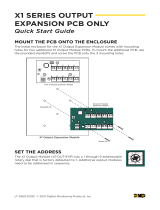
09/2016 Page 3 5IN2371 C
Wired Expansion Modules Installed on RISCO Bus Lines .......................................... 17
Describing Installer-Set ID Numbers for Bus Devices ................................................ 18
ID Number Formats .............................................................................................. 19
Assigning ID Numbers (Setting DIP Switches) for Bus Devices ............................. 20
Installing Bus Devices ................................................................................................ 21
Installing Wired Keypads ...................................................................................... 21
Connecting Individual Bus Detectors to a Bus at the Main Panel ........................ 21
Connecting Multiple Bus Detectors using Bus Zone Expanders ........................... 22
Step 4: Connecting Relay Detectors ........................................................................... 23
Defining Zone Termination Resistance ...................................................................... 24
Wiring Resistors for Zone Termination Resistance ............................................... 24
Zone Termination Configuration Options ............................................................. 24
Step 5: Connecting the Backup Battery and Mounting the Main Panel ...................... 25
Connecting the Backup Battery ................................................................................. 25
Mounting the Main Panel.......................................................................................... 25
SYSTEM INITIALIZATION, DEVICE ALLOCATION, GENERAL
SYSTEM CONFIGURATION ....................................................................... 26
Step 1: Working with the Keypad and Installer Menus .............................................. 26
Describing Dynamic Keypad Menus .......................................................................... 26
Table of Menu Navigational Keys ......................................................................... 26
Designating Labels ................................................................................................ 26
Entering the Installer Programming Menu at Initial System Setup ........................... 27
Subsequently Accessing Installer Menus .................................................................. 27
Step 2: Powering-Up and Initializing the System ....................................................... 27
Initial System Power-Up and Language Selection ..................................................... 27
Viewing Zones, Defining Partitions, and Setting the Time & Date ............................ 28
Viewing Zones, Defining Partitions, and Setting Time/Date at Initialization ........ 28
Viewing & Updating Zones and Defining Partitions after Initialization ................ 29
Step 3: Allocating and Configuring Installed Components ......................................... 30
Auto-Setting Allocation of Communication Modules and Bus Devices ..................... 30
Describing Auto-Setting Results ........................................................................... 31
Performing a Bus Test ............................................................................................... 31
Manually Allocating & Configuring Communication Modules .................................. 32
GSM Modules ....................................................................................................... 32




















